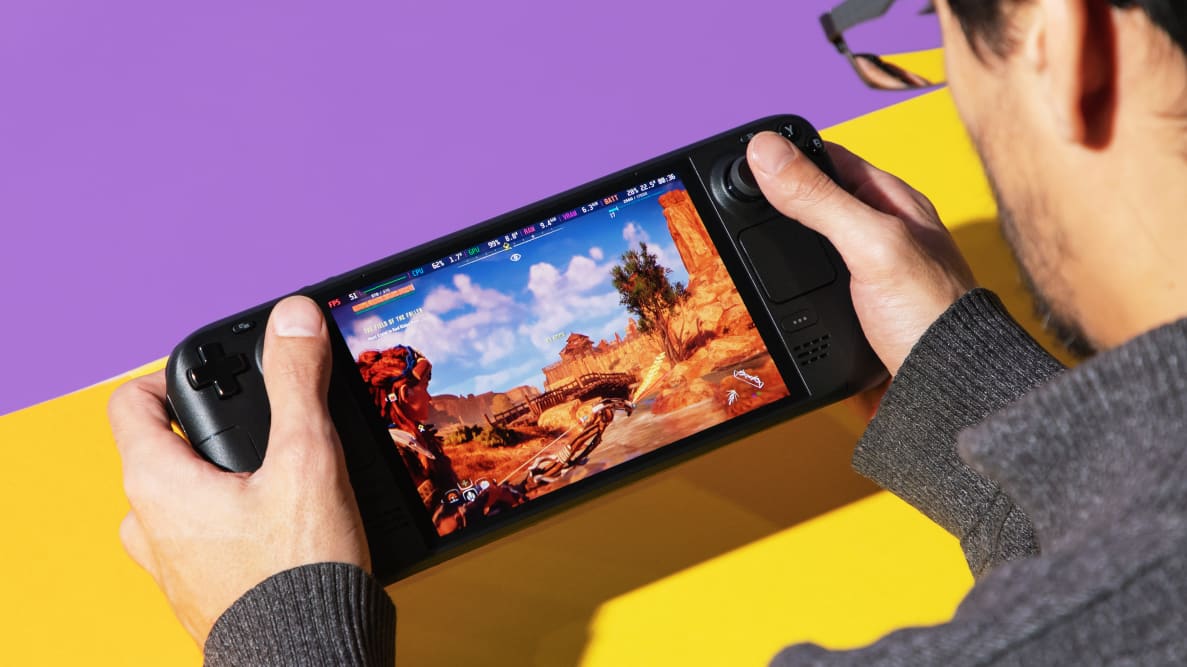Pros
-
Improved battery life
-
Excellent value
-
A truly fantastic screen
Cons
-
Only minor performance uplift
About the Steam Deck OLED

The Steam Deck OLED has a larger 7.4-inch screen but otherwise has the same dimensions as the LCD model.
On the outside, the Steam Deck OLED is nearly indistinguishable from the original. The bezels have been shrunk around the screen to increase the usable area up to 7.4 inches (from 7 inches), the thumbsticks have more concave toppers for better grip, and the power button is now orange. That’s it—the big changes are all under the hood.
The screen has been upgraded to a custom HDR OLED screen capable of displaying 110% of the P3 color space, and, because of the ability of OLED panels to turn completely off at an individual pixel level, it delivers perfect black levels and effectively infinite levels of contrast.
The larger 50Whr battery is 20% larger than what’s found in the original Deck. When combined with the smaller, more efficient APU, Valve estimates 30% to 50% longer battery life. The more efficient processor kicks off less heat, meaning that the Steam Deck OLED can use a much quieter fan.
The length of the charging cable attached to the power supply has increased from 4.92 feet (1.5 meters) up to 8.2 feet (2.5 meters). According to Valve, the Steam Deck OLED can charge from 20% to 80% in as little as 45 minutes thanks to advancements in battery chemistry.
The Steam Deck OLED is being sold in two tiers, with the original Steam Deck becoming the entry-level model at $399 with 256GB of internal storage. The Steam Deck OLED starts at $549 for the 512GB version, and $649 for the top-tier 1TB model, which includes an etched anti-glare finish and an additional slim carrying case that fits inside of the hardshell case that all models come with. For a limited time Valve is also selling a frosted gray translucent special edition of the 1TB model for $679. We reviewed the 1TB standard model.
Steam Deck OLED specs
- Price: $549 (512GB model), $649 (1TB model), $679 (1TB limited edition)
- Processor: AMD Zen 2 (4-core, 8-thread) 2.4-3.5GHz
- Graphics: 8 AMD RDNA 2 CUs, 1.0-1.66GHz
- Memory: 16GB 6400MHz LPDDR5 RAM
- Storage: 512GB PCIe 3.0 2230 NVMe SSD
- Battery: 50Whr
- Display: 1280 x 800 (16:10 aspect ratio), touch-enabled HDR OLED panel, 7.4-inches, 90Hz, 600 nits (rated for SDR), 1,000 nits (peak brightness with HDR enabled)
- Dimensions: 11.7 × 4.6 × 1.96 inches (at thickest point)
- Weight: 640 grams (22.57 ounces)
- Connectivity: Wi-Fi 6E, Bluetooth 5.3, 3.5mm headphone jack, microSD card slot, USB-C with DisplayPort 1.4 Alt-mode support
- Additional features: 2 x trackpads, 4 x remappable back buttons, 5-watt speakers, HD haptics, 6-axis gyro controls, dual ambient light sensors, included hardshell carrying case
- Warranty: One-year limited warranty
What we like
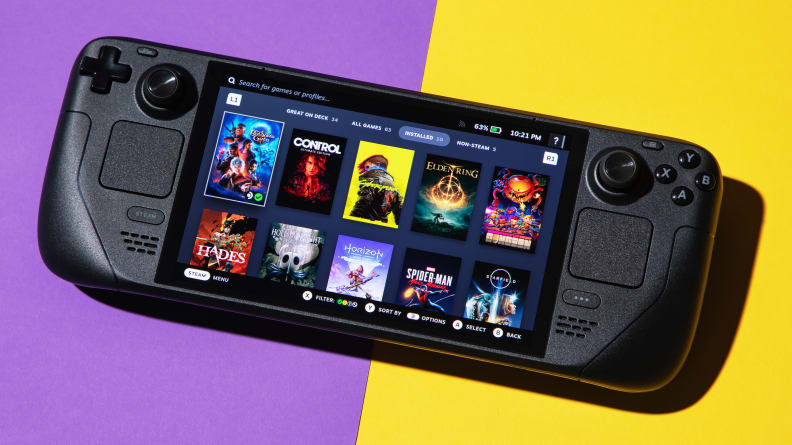
Dark games like Hollow Knight or Control are where the Steam Deck OLED really shines.
The OLED screen is killer
Valve isn’t the first to add an OLED screen to a PC gaming handheld (that credit goes to the discontinued Ayaneo Air Pro), but the Steam Deck OLED does boast the first handheld screen capable of HDR.
Whereas the first generation of Steam Deck used an off-the-shelf IPS panel (a portrait panel rotated sideways), the new OLED screen was custom-designed and manufactured. Not only does this eliminate issues with the display rotating when Windows is installed on the device, but Valve was able to tailor the new screen’s specifications to better suit the Steam Deck’s needs.
The new screen hits 90Hz, uses less power, is 200 nits brighter than the original Steam Deck’s max brightness, has blazing-fast pixel response times of 0.1 milliseconds, and can be removed and replaced without the need to disassemble the entire unit. That’s good news for tinkerers who break theirs and want to replace it on their own.
A common community complaint about the original Steam Deck is that the screen is dull, and one of the most popular fixes is to download third-party tools to artificially increase the saturation at the cost of color accuracy. But the Steam Deck OLED is colorful and accurate right out of the box, and even more so once you dial in the settings.
Games look uniformly great, and the difference is night and day between the two displays. Whether trawling through caves in Baldur’s Gate 3, roaming through dead cities in Elden Ring, shooting at robot dinosaurs in Horizon Zero Dawn, or mashing buttons in Hades, the colors pop.
But where the Steam Deck OLED shines is in darker games. Hollow Knight, Control, and any other game that relies on shadows or negative black space to create tension now lack the light bleed present on the original Deck and feel much more atmospheric.
While the new Steam Deck’s HDR ability isn’t a must-have feature, highlights are appropriately eye-searingly bright, shadows look dusky and realistic, and colors are more nuanced and natural with it enabled. It’s more of a “nice to have” feature that puts the Steam Deck OLED technically ahead of competitors in the screen department. And don’t worry if you’re one of those people who like to play in the dark before bed; the Steam Deck OLED gets even darker than the original at minimum brightness.
I would have preferred a variable refresh rate (VRR) capable screen instead, like the one on both versions of the Asus ROG Ally. VRR dynamically adjusts the device’s refresh rate to match what the game onscreen is putting out, which cuts down on judder and makes for a smoother gaming experience.
Also, I have a personal nitpick about the 1TB model Valve sent us to review: the etched anti-glare coating does an admirable job of cutting down on errant light, but it also adds a matte finish to the screen and a slight haze to everything. A glossy finish would enhance the perceived darkness in black areas and color richness more.
It runs longer and quieter
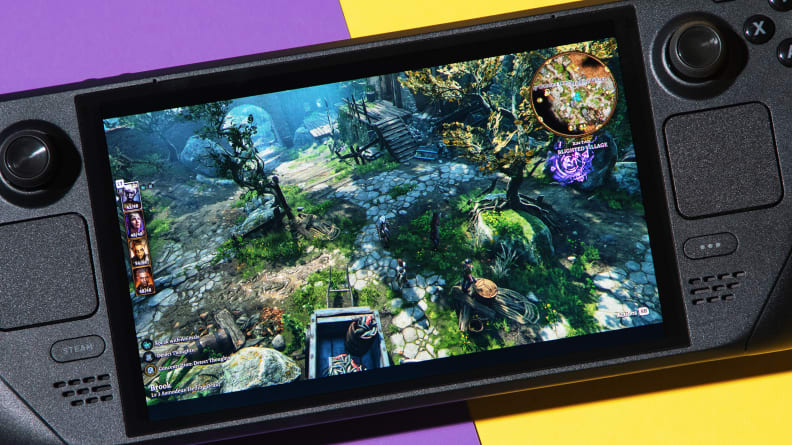
HDR lends games that support it an additional layer of richness and color accuracy.
The other biggest changes inside the Steam Deck OLED are the 50Whr battery and refreshed APU. The original Deck used a 40Whr battery, and Valve moved the custom processor inside from a 7nm to 6nm production node, meaning it can eke out the same performance from a smaller, more power-efficient package.
Valve claims these changes, along with the more efficient screen, add up to anywhere from 30% to 50% more game time. I believe it; in games that push the Steam Deck’s APU to its maximum draw of 15 watts, the Steam Deck OLED delivers about 2 hours and 15 minutes of playtime, up from about an hour-and-a-half on the original Steam Deck. If you play indie games that sip power, the gains will be much larger.
The last-generation Steam Deck sounds like a jet taking off when the SSD is stressed, but that’s been remedied. I raved about how quietly the Asus ROG Ally runs in my review, and Valve has finally matched the competition. Thanks to a larger fan and more efficient processor, the new Steam Deck runs much cooler and the fan noise is no longer audible except when you boot the device up. We couldn’t push the Steam Deck OLED past 75 degrees Celcius during game testing.
The quality-of-life upgrades

The Steam Deck OLED has a newer internal layout with more easily accessible daughterboards.
Valve has sprinkled several small quality-of-life upgrades across the Steam Deck OLED (nearly all of them internal) that make it a much more pleasant device to use.
Before even turning the new Deck on, it’s clear that this is a noticeably lighter device. Although Valve only trimmed the weight by about 5% (29 grams), they must have shifted the internals around in such a way as to better balance it. If you hold both models of the Steam Deck, it becomes apparent which is which based on feel alone.
When you turn the new Deck on, the touchscreen and trackpads feel snappier and more responsive, in part due to the higher polling rate. But the biggest surprise is the audio. While the original Deck had great forward-firing speakers, the Steam Deck OLED’s are even better and I would now put them on par with the ROG Ally’s. Their sound is warmer and gets loud enough to easily fill a room when cranked up, but still lacks bass on the low end.
Although Valve technically recommends against users upgrading internal parts on their own, it’s now easier than ever to tinker with the Deck. Torx screws are now used throughout to reduce the risk of stripping a screw, and everything is now held in place with similarly-sized machine screws. The number of screws was also reduced throughout, making repairs easier. I didn’t dig too deeply into the new Steam Deck’s guts as I didn’t have a disassembly guide handy, but everything did appear to be neatly laid out in a series of easily accessible daughterboards.
Because the screw locations—and everything else—are the same between devices, that means all of your favorite Steam Deck accessories, skins, and third-party back plates will work flawlessly. I had no problem using my regular Jsaux dock for Ethernet in and video out, though you may want to upgrade as the new Deck supports 120Hz 4K video out, up from 60Hz.
The value
The original Steam Deck was a stellar value at launch and Valve continues to undercut its competition in this area. The 512GB Asus ROG Ally Z1 Extreme, the Deck’s closest competitor, has dropped as low as $600 on sale, but that’s $51 more than the 512GB Steam Deck OLED.
Yes, the ROG Ally Z1 Extreme and Lenovo Legion Go are more powerful and boast screens that hit 1080p and 120Hz, and 1600p and 144Hz, respectively, but the Steam Deck OLED has a more accurate and vibrant screen and longer battery life than either. Ayaneo’s similarly powerful handhelds like the Ayaneo Air Plus have, at the time of writing, gone on sale for under $600, but they can’t match Valve’s customer support and warranty.
And if you just want the cheapest device capable of running new PC games, the 256GB Steam Deck (non-OLED) at $399, or as low as $300 for a refurbished unit, is even more compelling.
What we don’t like

Your games will run a smidge better, but don't expect a next-gen performance leap.
Performance is better but still staid
Just because the Steam Deck OLED is a new version of the Deck doesn’t mean it can run high-fidelity, big-budget new games like Alan Wake 2. (It can run it, but can’t maintain a steady 30 frames per second (fps) and it doesn’t look great.) Valve intentionally kept the same performance target for developers across devices, which in lay terms means keeping the performance approximately the same.
RAM speed on the new Deck has been bumped up to 6400MHz from 5500MHz. Valve claims the speed increase helps the device wake from sleep faster and ensures smoother gameplay by decreasing latency, but it also makes performance on the Steam Deck OLED a bit better than the original. Current-gen AMD Ryzen processors love faster RAM, so this was an easy way to juice the device.
In practice, it translates to about a 10% increase in game performance. Whereas I found Elden Ring unplayable on the original Steam Deck after finishing it on my PC, it’s much more bearable on the Steam Deck OLED, where I was able to maintain over 40 fps at low settings even in the open world.
Running the built-in Horizon Zero Dawn benchmark at 800p on original settings with no upscaling netted an average of 50 fps on the Steam Deck OLED, versus 46 fps on the first-generation Deck. Cyberpunk 2077 was the same; the Steam Deck OLED pulled 48 fps on that game’s benchmark at the stock Steam Deck graphics preset, while the original only eked out 44 fps.
It’s a nice uplift and makes demanding games like Baldur’s Gate 3 much more playable, but competitors using AMD’s integrated Radeon 780M GPU like the Asus ROG Ally Z1 Extreme and Lenovo Legion Go are up to 20% faster (or more in certain situations) and can push games at higher resolutions.
The Steam Deck is still a powerful machine for emulation and can handle most games that you throw at it, but performance is getting a bit long in the tooth. If you were hoping for a new device that can run the most graphically intense new games without compromises, you’d be better off waiting for the Steam Deck 2.
Should you buy the Steam Deck OLED?
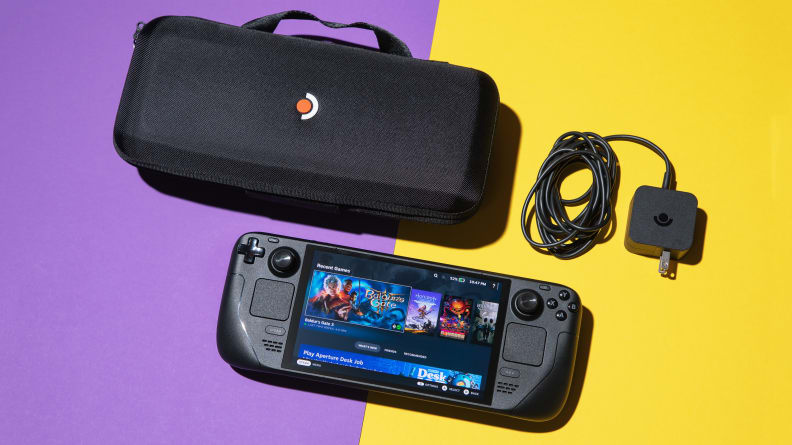
The Steam Deck OLED comes with the familiar hardshell carrying case and a longer charger. The 1TB model comes with an additional slim case.
Yes, unless you’re happy with the Steam Deck you already own
The first generation of Steam Decks felt more like a hodgepodge of off-the-shelf parts that Valve cobbled together to hit a super low price point. The Steam Deck OLED, on the other hand, finally feels like a PC gaming handheld that was built from the ground up.
The HDR OLED screen is a stunner, the device’s ergonomics are better than ever, and the leap in battery life and storage is a balm to early adopters who were otherwise pleased with their purchase. If you don’t already own a Steam Deck, ROG Ally, Lenovo Legion Go, or any of the other competitors but are interested in handheld PC gaming, the Steam Deck OLED is a no-brainer.
If you already own a Steam Deck, though, I would weigh the pros and cons of upgrading. The original is still a great gaming device and a Steam Deck 2 likely won’t debut until 2025. But even if you’re happy with the Steam Deck experience and wish it was just a half-step better, the OLED version won’t disappoint. It’s one of the best consoles you can buy.
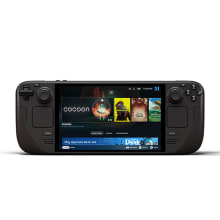
The Steam Deck OLED improves on the original in nearly every way.
Meet the tester
Jonathan is an Electronics Editor for Reviewed specializing in gaming gear and has experience with everything from controllers to benchmarking the latest GPUs. He was previously the Web Editor at The Architect's Newspaper.
Checking our work.
Our team is here to help you buy the best stuff and love what you own. Our writers, editors, and experts obsess over the products we cover to make sure you're confident and satisfied. Have a different opinion about something we recommend? Email us and we'll compare notes.
Shoot us an email
